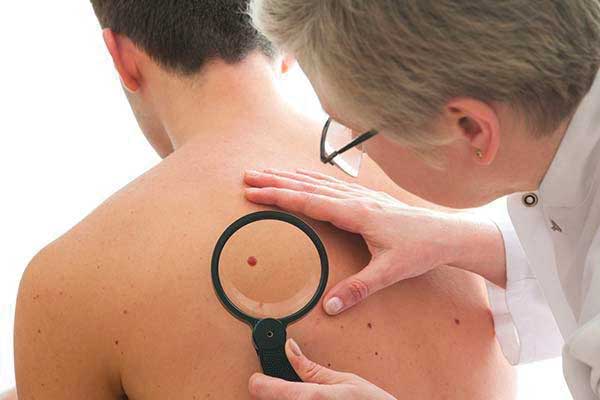SKIN CANCER 101
By Sanaz Majd, MD
The month of May is dedicated to Skin Cancer Awareness Month—right on cue before the fun in the sun activities of the summer. That means beach and pool parties, outdoor sports, summer picnics, and beach vacations during these smoldering months. But truthfully, for those of us living in Southern California, we should be concerned about our skin every month of the year.
So, most of us have some moles and freckles, but how can you tell if a spot on your skin is concerning? What are the different types of skin cancer? And what should you look for when deciding on what type of sunscreen to purchase when there are SO many on the shelf to choose from? Let’s discuss all of this and more.
3 Types of Skin Cancer
The main 3 categories of skin cancer are:
• Squamous cell carcinoma
• Basal cell carcinoma
• Melanoma

Squamous cell and basal cell cancers are typically less worrisome because they do not tend to metastasize (i.e., spread through the bloodstream or lymphatic system to other parts of the body) and, hence, are not life-threatening. They stay localized and simply grow in size through time if not addressed.
But these types of cancers can be potentially disfiguring—the longer a carcinoma is left ignored, the larger the scar will be after removal and this can be significant for certain locations, such as the face, as you can imagine.
Most patients I’ve seen with skin cancer within these first two categories are typically older in age, people who are paying the price for spending years in the sun. And therefore, the cancer tends to occur on sun-exposed areas such as the face, arms, and legs. Anyone remember the “baby oil” baking-in-the sun era? Yep, these baby boomers are now the harbors of squamous cell and basal cell carcinoma as a result, unfortunately. Thankfully (and hopefully), those days are gone for most of us, as we now know that basking in baby oil is not the way to go.
Melanoma
The dreaded melanoma, on the other hand, is much more worrisome because it does have a potential to metastasize if not caught early and can, hence, be life-threatening. Here, our skin cells produce a pigment referred to as “melanin” which overgrows and goes out of whack to become cancerous.
Melanoma lesions are most often dark brown or black, but they can be any color (including white). Melanoma can affect people at any age. I will never forget my 21-year-old patient who very sadly passed away from melanoma—it appeared in a mole that she had since childhood. It seemed to have “changed” appearance through time, but because she had it throughout her childhood she didn’t think anything of it. Who could blame her? How many 21 year olds think about skin cancer?
The other unique feature of melanoma is that it can occur anywhere on the surface of the body…literally. I have had patients with melanoma in the eye and, in a female, on her labia (outer genitals). It is a myth that it is always in sun-exposed regions. This is because there is a genetic potential for melanoma, as the genes can be passed down from parents regardless of how much time is spent in the sun.
Most melanoma in women is found on the legs or feet, and this could mean underneath the feet, under the toenails, or even in between the toes. In men it is most often discovered on the back, a rather challenging location to view on your own.
Yes, melanoma can be a sneaky one. So pay attention.
Skin Cancer Risk Factors
Certain populations have a higher risk of developing skin cancer and these include people who have:
• Light-complexioned skin
• Naturally blond or red hair
• Blue, green, or hazel eyes
• Family history of skin cancer (especially melanoma)
Symptoms of Melanoma
There’s a mnemonic device that can help you distinguish more serious lesions that are potentially suspicious. We refer to this as the “ABCDEs” of melanoma. Everyone with moles and spots on the skin should learn to recite this:
• A = Asymmetry: If you split the skin lesion in half, is it symmetrical? Does one half look like the other? Melanoma is often NOT symmetric.
• B = Border: Moles with irregular borders, jagged edges, or borders that you cannot clearly distinguish are considered more suspicious.
• C = Color Variation: Spots that have more than one shade or color within—for instance, a light and darker shade of brown within the same mole—are more concerning for melanoma.
• D = Diameter: Generally, moles larger in size than the end of your pencil eraser are more suspicious.
• E = Evolving: Even a skin lesion that is symmetrical, with smooth borders, uniform color, and smaller than a pencil eraser should be brought to your doctor’s attention if it is changing in any way. This could mean if it is growing in size, is now itchy or bleeding, is swollen, or the shape or color is changing over time, etc. As I mentioned, melanoma can appear even in birthmarks.
How Is Skin Cancer Diagnosed?
Your doctor may take a biopsy (a superficial sample) of any suspicious lesions. The biopsy is then sent to the pathologist who examines the sample under a microscope and then confirms the diagnosis.
Those with skin cancer, most especially melanoma, are often referred to a skin specialist called a dermatologist. They will keep a closer eye on your skin throughout time, as people who have had skin cancer once are more likely to develop it again and often somewhere else on the body.
How to Prevent Skin Cancer
We now know that the sun’s rays, not to mention those of the tanning salon, are very harmful to our skin. Not only do the rays increase the risk of skin cancer, but cause wrinkles and premature aging.
Sun-kissed skin is no longer the sought-after fad it once was. The best way to prevent skin cancer is to protect your skin as early on as childhood—we need to teach our next generation how to do this properly:
• Avoid the sun: Avoid the sun’s peak hours, from 10 a.m. to 4 p.m., when the rays are strongest.
• Cover up: If spending time outdoors, stay in the shade and wear a broad-brimmed hat, long sleeves, and pants if possible.
• Apply sun protection: Wear sunscreen on all sun-exposed areas when leaving the house, even if you’ll just be in the car. The sun’s rays will reach you no matter where you are. If spending time outdoors, reapply every two hours—sunscreen starts to lose its efficacy past this time frame. Choose a product with the following properties:
• SPF 30 or higher
• With both “UVA and UVB” protection written on the bottle
• With main ingredients titanium and/or zinc oxide, which are more protective
• Do monthly skin checks: Invest in a full-length mirror and survey your skin once a month, while keeping the ABCDEs of melanoma in mind.
• Avoid the tanning salon: There was a time when we thought perhaps the tanning booth’s rays weren’t as harmful. Now we know better. The salon rays are just as harmful, if not worse.
Don’t get me wrong, I am all for some summertime fun, but it does not necessarily have to be in direct sun. And if it does, protect yourself and your loved ones by following these easy tips to keep life-long beautiful (and healthy) skin.
________________________________________
REFERENCES:
1- Skin Cancer Foundation: https://www.skincancer.org/
2- American Academy of Dermatology: https://www.aad.org/public/diseases/skin-cancer/prevent/how
3- National Cancer Institute: https://www.cancer.gov/types/skin/patient/skin-prevention-pdq
4- American Cancer Society: https://www.cancer.org/cancer/melanoma-skin-cancer.html

















